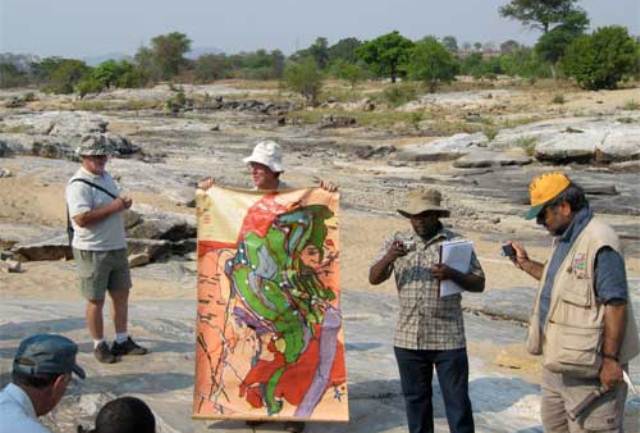The Centennial Field Excursion to the Belingwe Greenstone Belt and the Great Dyke
Submitted by Julie Kuhn on Fri, 12/09/2014 - 14:33 

The Centennial Field Excursion to the Belingwe Greenstone Belt and the Great Dyke, Led by Dr. Tony Martin, 23rd – 25th October 2010
A group of some 34 eager participants assembled outside the Crown Plaza Hotel early on the morning of Saturday 23rd October, the day following closure of the two-day symposium that celebrated the hundred years of the Zimbabwe Geological Survey. Separating into a fleet of locally provided motor vehicles, in which our visitors were evenly spread, the object was to reconvene at the Nilton Hotel in Zvishavane in good time to draw breath and head for the field. See the team in the front-page photograph.
This was achieved, and we headed south out of town, past the Shabanie asbestos mine and the Sabi gold mine, to arrive at the famous, much visited Type-Section for the Manjeri Formation at the unconformity exposure of these Upper Greenstone or Bulawayan rocks over a granitoid basement of the Shabani Gneiss. The writer had first visited here in 1975 with Professor Preston Cloud and the full Belingwe Team comprising Tony Martin, Mike Bickle, Euan Nisbet and John Orpen, and again in September 1980 with the post-Independence excursion that included such visitors as Carl Annhaeuser, Richard Viljoen, Jay Barton, Maarten de Wit, Matt du Toit and Clive Barton, as well as Jim Wilson. Since then Tony Martin has led some hundreds of visitors on visits to the Belingwe Belt, and each time he says he learns more based on the animated discussions the various exposures provoke, sometimes controversially. On this occasion our Centennial group included in its ranks Euan Nisbet on a passionate re-acquaintance with his rocks, Mike Watkeys from UKZN, Sharad Master and Allan Wilson from Wits, Jan Kramer from Johannesburg University, Paul Mason from Utrecht, a goodly and necessary contingent from the ZGS and fine representation from our own society membership, a collection that left little doubt as to the caliber of discussion that was to ensue.
The group then proceeded to the Reliance Formation Type-Section, a tributary exposure of komatiitic lithologies that was traversed up from the Ngezi River confluence, where today no hippo reside. Missing out exposures of the Cheshire Formation conglomerate, the final stop of the day in the south-east of the greenstone belt involved a drive along the railway line before intercepting the Ngezi River upstream of our previous encounter. Here the group was treated to superb exposures of basaltic pillow lavas, tuffs and breccias within the intervening Zeederbergs Formation. The renowned stromatolite exposures of the Cheshire Formation could not be visited on this trip due to their remoteness and our time constraint. The group returned to the Nilton in the gloaming for a well-earned beer and their memorable chicken or beef cuisine.
On day two the convoy proceeded west from Zvishavane across the Zeederburgs to the Mtshingwe Dyke cutting, which commands a view south to the Lower or Belingwean greenstone succession centred on the iron-formation of Belingwe Peak and the komatiitic Bend Formation deformed by the prominent and steeply NE-plunging syncline in that area. On and to the west exposures of the Lower Greenstones reveal a perceived volcanic vent within the intermediate Hokonui Formation, bearing the name of the farm that hosts Dadaya Mission hand the former home of Garfield Todd, one-time Prime Minister of Southern Rhodesia. Then in the bed of the Dohwe River, right-bank tributary to the Mtshingwe, some superb exposures Hokonui pyroclastic flows were examined, and some members were distracted by the sight of gold tails in the pans of local maporakosa who work the gravels trapped between the rough rocky protuberances.
Perhaps the sequence that caught the imagination of most was that known as ‘Hall’s Flow’ through the komatiitic Reliance Formation, particularly the columnar jointing and both olivine and pyroxene spinifex textures.

Columnar jointing in a peridotite sill in the “Hall’s Flow” exposure of the Reliance Formation,
Belingwe Greenstone Belt, and Forbes for scale. Photo: TJB
The final stop of the day was also to view komatiitic flows and tuffs of the Reliance Formation exposed in the Mtshingwe river bed close to the old NA antimony mine. Another stimulating day.
Breakfast on the 25th witnessed a few small presentations and thank you’s, as some members were per force on their way. The group then departed east on the Masvingo road, across the Runde bridge before doubling back to the old low-level bridge where pavements of the banded Shabani Gneiss in the ancient Tokwe Segment are magnificently exposed, and have been viewed on innumerable occasions since the Granite’71 field excursion. Returning, a cutting on the main road exposes quartz gabbro of the East Dyke, satellite to the Great Dyke.

Tony Martin upon the MSZ at Bougai.
Our return towards Harare along the road to Shurugwi and Gweru took us up the southern extent of the Shurugwi Sub-Chamber past active chrome mining and through cyclic units of Great Dyke pyroxenite and hartzburgite to the new Bougai platinum exploration camp south of Unki Mine. Here Tony Martin has been consulting and Allan Wilson was now in his element. With welcome drinks in hand the concluding remarks were expounded with Tony sitting on the actual exposure of the MSZ, perhaps uninspiring if one was not in the know. A fitting conclusion for our celebrations, and a wonderful, inspiring time was had by all. Thanks to Tony and all who put their effort into the trip’s success.
Tim Broderick

